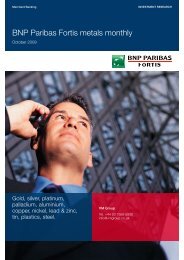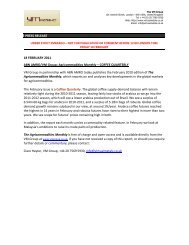BNP Paribas Fortis North American energy monthly - Virtual Metals
BNP Paribas Fortis North American energy monthly - Virtual Metals
BNP Paribas Fortis North American energy monthly - Virtual Metals
You also want an ePaper? Increase the reach of your titles
YUMPU automatically turns print PDFs into web optimized ePapers that Google loves.
14 | <strong>BNP</strong> <strong>Paribas</strong> <strong>Fortis</strong> <strong>North</strong> <strong>American</strong> <strong>energy</strong> <strong>monthly</strong> | October 2009 <strong>BNP</strong> <strong>Paribas</strong> <strong>Fortis</strong>/VM Group<br />
Power<br />
News<br />
• Sept 28 th : Canadian Hydro bought the rights to develop a 4,400 MW offshore<br />
windfarm in Lake Ontario from Wasatch Wind. No terms were disclosed.<br />
• Sept 17 th : BrightSource Energy said it has abandoned plans to build a<br />
controversial solar power plant in the eastern Mojave Desert.<br />
• Sept 17 th : Sempra Energy bought a half share in BP’s 200 MW Fowler<br />
Ridge 2 windfarm in Indiana.<br />
Analysis<br />
• EPA gathers its carbon data<br />
From next New Year’s Day, 10,000 industrial facilities in the US will have to<br />
collect data on greenhouse gas emissions and submit the information to the<br />
Environmental Protection Agency (EPA). “This is a major step forward in our<br />
effort to address the greenhouse gases polluting our skies,” said EPA<br />
Administrator Lisa Jackson. The new program, details of which were announced<br />
in late September, will cover about 85% of the emission sources in the US and<br />
will be an important stepping stone in creating a nationwide verifiable databank<br />
to combat climate change. The data will also allow individual businesses to track<br />
their own emissions, compare them with similar facilities elsewhere in the<br />
country, and provide guidance on identifying cost-effective ways to reduce<br />
future emissions.<br />
Market manipulation is one of those things that can be easy to suspect but<br />
difficult to prove. Well, the Federal Energy Regulatory Commission (FERC)<br />
went out of its way in mid-September to dispel any doubt that it would pursue<br />
parties involved in the practice when it approved a record $30m settlement<br />
against Energy Transfer Partners (ETP) over allegations that it had manipulated<br />
physical wholesale natural gas prices at Houston Ship Channel over a two-year<br />
period starting in 2003. Under the settlement, ETP will pay a $5m civil penalty<br />
and establish a $25m fund to pay alleged unjust profits to entities that file claims<br />
within a 60-day period after publication in the Federal Register. Any funds left<br />
over after that period will be paid to the US Treasury. Sounding like a vintage<br />
TV crime-fighter, Norman Bay, director of FERC's Office of Enforcement, said<br />
his agency would “investigate, punish and deter manipulation of the <strong>energy</strong><br />
markets.”<br />
Since its inception in 2007, the annual GridWeek conference on the future of the<br />
smartgrid has become an essential venue for policymakers, regulators and<br />
utilities alike. This year’s gathering was no exception with Energy Secretary<br />
Steven Chu giving the keynote speech and announcing $144m in government<br />
funding for training a new generation of grid workers. Of the total, $40m will be<br />
available to develop training programs devised by utilities, universities, trade<br />
schools and labor organizations, with a further $60m set aside to actually train<br />
new employees and retrain existing staff about the use of the smartgrid. On top<br />
of this, an additional $44m has been earmarked for training within state public<br />
utility commissions. The government message to this conference was that the<br />
smartgrid had already become an essential part of federal policy aspirations and<br />
that it was prepared to invest heavily to bring it about. With 1,500 delegates<br />
from 22 countries, the conference looked at early smartgrid applications in<br />
Texas, Colorado and California, leaving few doubts that the US has already built<br />
up an enviable lead in this new grid development.<br />
Outlook<br />
The upturn in the economy and the improved prospects of the power sector<br />
are evident if you want to look for them. With the federal government<br />
prepared to pump money into power infrastructure, private investors will<br />
inevitably follow. Next year will prove to be an important watershed.














